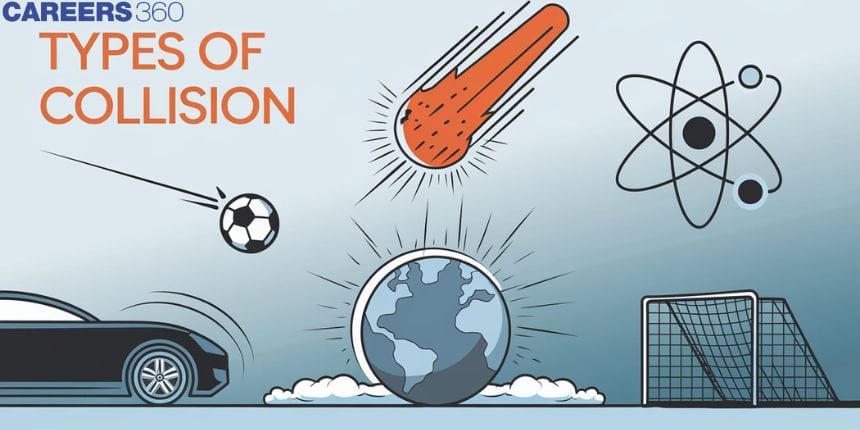Types Of Collision
Linear momentum, a fundamental concept in physics, plays a crucial role in understanding the motion of objects. It is defined as the product of an object's mass and velocity, indicating how much force is needed to change its motion. There are various types of linear momentum, such as translational, angular, and relativistic, each relevant in different scenarios. For instance, when you push a shopping cart, the cart's linear momentum increases as it accelerates, making it harder to stop. Similarly, understanding linear momentum helps explain everyday phenomena like car collisions, where the momentum of each vehicle determines the impact's outcome. By exploring these types, we gain a deeper insight into the laws of motion that govern our daily lives.
This Story also Contains
- Linear Momentum
- Solved Examples Based on Linear Momentum
- Summary

Linear Momentum
Linear momentum is a core concept in physics that helps us understand how objects move and interact. Defined as the product of an object's mass and its velocity, linear momentum reflects how much force is required to alter the motion of that object.
The linear momentum of a body is the quantity of motion contained in the body.
It is measured in terms of the force required to stop the body in a unit of time.
If a body of mass m is moving with velocity, then its linear momentum $\vec{p}$ is given by $\vec{p}=m \vec{v}$.
It is a vector quantity and its direction is the same as the direction of the velocity of the body.
S.I. Unit : kg-m/sec
Dimension- MLT-1
If two objects of different masses have the same momentum, the lighter body possesses greater velocity.
As $\mathrm{p}=\mathrm{m}_1 \mathrm{v}_1=\mathrm{m}_2 \mathrm{v}_2=$ constant
$\therefore \frac{V_1}{V_2}=\frac{m_2}{m_1} \Rightarrow V \alpha \frac{1}{m}$
Recommended Topic Video
Solved Examples Based on Linear Momentum
Example 1: An object of mass 1 kg travels at a constant speed of 10 m/s. Calculate the linear momentum (in kg-m/s )of the object.
1) 10
2) 40
3) 30
4) 15
Solution:
Given : Mass, $(m)=1 \mathrm{KgSpeed},(v)=10 \mathrm{~m} / \mathrm{sSo}$, Linear momentum, $\vec{p}=m \vec{v}$ $\vec{p}=m \vec{v} \Rightarrow \vec{p}=1 \mathrm{~kg} \times 10 \mathrm{~m} / \mathrm{s}=10 \mathrm{~kg} \mathrm{~m} / \mathrm{s}$
Hence the answer is the option (1).
Example 2: If the speed and mass of an object are doubled, which of the following is true?
1) The momentum of the object is doubled
2) The momentum of the object is quadrupled.
3) The momentum remains the same.
4) The momentum is halved.
Solution :
Given :
Speed, $(v)=2 v$
Mass, $(m)=2 m$
We know,
Momentum, $(p)=m v$
According to the question of mass and speed is doubled. Then, $p=2 m \times 2 v=4 m v=4 p$
Hence the answer is the option (2).
Example 3: A ball of mass 0.20 kg hits a wall at an angle of $45^{\circ}$ with a velocity of $25 \mathrm{~m} / \mathrm{s}$. If the ball rebounds at $90^{\circ}$ to the direction of incidence with the same speed. Calculate the magnitude of change in momentum of the ball.
1) $5 \sqrt{2} \mathrm{Ns}$
2) 5 Ns
3) $3 \sqrt{2} \mathrm{~N} \mathrm{~s}$
4) 10 Ns
Solution:
Given
mass, $\mathrm{m}=0.2 \mathrm{~kg}$
initial and final speed, $\mathrm{v}=25 \mathrm{~m} / \mathrm{s}$
The magnitude of Initial linear momentum $\left(\overrightarrow{p_i}\right)$ and final linear momentum $\left(\overrightarrow{p_f}\right)$
$
p=\left|\overrightarrow{p_f}\right|=\left|\overrightarrow{p_i}\right|=m v \Rightarrow p=5 \mathrm{~kg} \cdot \mathrm{m} / \mathrm{s}
$
The angle between the initial and final momentum vectors is $90^{\circ}$, as shown in the figure below

Change in linear momentum
$\begin{aligned} & \Delta \vec{p}=\overrightarrow{p_f}-\overrightarrow{p_i} \\ & |\Delta \vec{p}|=\left|\overrightarrow{p_f}-\overrightarrow{p_i}\right| \\ & |\Delta \vec{p}|=\sqrt{p^2+p^2-2 p^2 \cos 90^0} \\ & |\Delta \vec{p}|=\sqrt{2} p \\ & \Rightarrow|\Delta \vec{p}|=5 \sqrt{2} \mathrm{~kg} \cdot \mathrm{m} / \mathrm{s}\end{aligned}$
Hence the answer is the option (1).
Example 4: A ball is thrown vertically up (taken as + z-axis) from the ground. The correct momentum-height (p-h) diagram is :
1)
2)
3)
4)
Solution
As we know,
$
\begin{aligned}
& v^2=u^2-2 g h \\
& v=\sqrt{u^2-2 g h} \\
& |P|=m v \\
& |P|=m \sqrt{u^2-2 g h}
\end{aligned}
$
Therefore, the graph between p and h cannot have a straight line.
During the upward journey as h increases, p decreases, and in the downward journey as h decreases p increases.
Hence the answer is the option (4).
Example 5: An object is thrown vertically upwards. At its maximum height, which of the following quantities becomes zero?
1) Momentum
2) Potential Energy
3) Acceleration
4) Force
Solution:

$\rightarrow$ At maximum height, its velocity becomes zero
$\rightarrow$ Therefore, the momentum of the object becomes zero
Hence the answer is the option (1).
Summary
Linear momentum, defined as the product of an object's mass and velocity, is a crucial concept in physics that helps explain the motion of objects. It is a vector quantity, with its direction aligning with the object's velocity. The momentum of an object determines the force required to change its motion. Key examples include calculating momentum changes in collisions and understanding the effects of doubling an object's mass and velocity.



